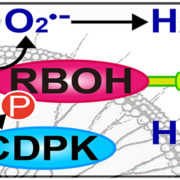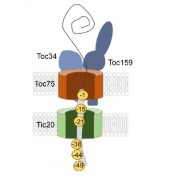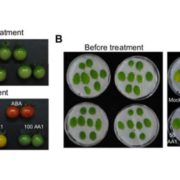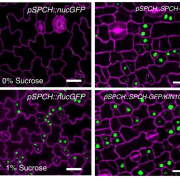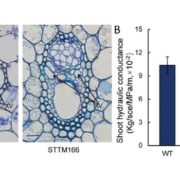The Cys-Arg/N-end rule pathway is a general sensor of abiotic stress in flowering plants
 The N-end rule pathway is a conserved pathway for the control of protein turnover, through which the clipping or modification of amino acids from the amino-terminus of a protein leads to an interaction with PROTEOLYSIS 6 (PRT6; an N-recognin E3 ligase) and 26S proteasome-mediated proteolysis. Previously, hypoxia (low oxygen) and nitric oxide (NO) were shown to be sensed by the oxidation state of an N-terminal Cys residue of a subset of ERF transcription factors known as ERFVII. Vicente, Mendiondo et al. show other abiotic stresses are sensed through N-rule pathway regulation of ERFVII levels. Barley and Arabidopsis plants with constitutively-stabilized ERFVIIs (e.g., through loss of activity of PRT6) show enhanced survival when challenged with heat, salt, drought and oxidative stresses, whereas mutant depleted in ERFVII activity showed less stress tolerance. These results indicate that ERFVIIs are stabilized during stress, and the authors showed that NO levels are decreased during stress due to a decrease in nitrate reductase activity. These and other findings suggest that, “stabilized ERFVIIs contribute to multiple protein-network hubs that balance growth, development, and response to environmental stresses.” Curr. Biol. 10.1016/j.cub.2017.09.006
The N-end rule pathway is a conserved pathway for the control of protein turnover, through which the clipping or modification of amino acids from the amino-terminus of a protein leads to an interaction with PROTEOLYSIS 6 (PRT6; an N-recognin E3 ligase) and 26S proteasome-mediated proteolysis. Previously, hypoxia (low oxygen) and nitric oxide (NO) were shown to be sensed by the oxidation state of an N-terminal Cys residue of a subset of ERF transcription factors known as ERFVII. Vicente, Mendiondo et al. show other abiotic stresses are sensed through N-rule pathway regulation of ERFVII levels. Barley and Arabidopsis plants with constitutively-stabilized ERFVIIs (e.g., through loss of activity of PRT6) show enhanced survival when challenged with heat, salt, drought and oxidative stresses, whereas mutant depleted in ERFVII activity showed less stress tolerance. These results indicate that ERFVIIs are stabilized during stress, and the authors showed that NO levels are decreased during stress due to a decrease in nitrate reductase activity. These and other findings suggest that, “stabilized ERFVIIs contribute to multiple protein-network hubs that balance growth, development, and response to environmental stresses.” Curr. Biol. 10.1016/j.cub.2017.09.006



